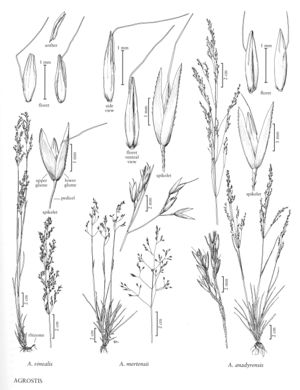Difference between revisions of "Agrostis mertensii"
FNA>Volume Importer |
FNA>Volume Importer |
(No difference)
| |
Revision as of 19:17, 24 September 2019
Plants perennial; cespitose, not rhizomatous or stoloniferous. Culms (5)10-40 cm, erect, with 2-4 nodes. Leaves mostly basal or basal and cauline, basal leaves persistent; sheaths smooth or scabrous; ligules 0.7-3.3 mm, scabridulous or smooth, usually rounded, sometimes acute or truncate, erose, sometimes lacerate; blades 2.5-13 cm long, 0.5-3 mm wide, usually flat, occasionally involute or folded. Panicles (2)3-10 cm long, (0.5)1.5-5 cm wide, widely ovate to lanceolate, usually open, exserted from the upper sheaths at maturity, lowest node with (1)2-5 branches; branches erect, not capillary, readily visible, smooth or sparsely scabridulous, branched above midlength, spikelets in the distal 1/2 or beyond, lower branches (1.5)2-4 cm; pedicels 0.4-6.4 mm. Spikelets lanceolate to narrowly ovate, dark brown or purplish. Glumes subequal, 2-4 mm, elliptical to lanceolate, midveins scabrous to scabridulous, at least distally, 1-veined, acute; callus hairs to 0.4 mm, sparse; lemmas 1.6-2.6 mm, smooth or scabridulous, translucent to opaque, 5-veined, veins prominent to obscure, apices acute, entire or erose, awned from just below midlength, awns (2)3-4.4 mm, geniculate, exserted, persistent; paleas absent, or to 0.1 mm and thin; anthers 3, 0.5-0.8 mm, usually shed at anthesis. Caryopses 1.4-2 mm; endosperm solid. 2n = 56 [reports of 2n = 42 are for Agrostis scabra].
Distribution
Maine, N.H., Alta., B.C., Greenland, Man., N.B., Nfld. And Labr., N.W.T., Nunavut, Ont., Que., Sask., Yukon, Colo., Utah, Wash., N.Y., W.Va., Alaska, N.C., Vt., Tenn., Mont., Va., S.C., Wyo.
Discussion
Agrostis mertensii grows on banks and gravel bars in river and lake valleys, and on open grasslands and rocky slopes of mountains and cliffs. It has a circumboreal distribution. In the Flora region, it extends from Alaska across Canada to Newfoundland and Greenland, south in the mountains to Wyoming and Colorado in the west, and West Virginia, Tennessee, and North Carolina in the east. It also grows in arctic Europe, Scandinavia, the mountainous regions of Mexico, and northwestern South America, where some unusually robust specimens have been somewhat dubiously referred to this species.
Agrostis mertensii is frequently confused with dwarf, awned forms of A. scabra (p. 646), but has larger spikelets, more culm nodes, larger anthers, slightly wider, flatter leaves, and panicles that are less expanded and less than lh the culm length. Agrostis mertensii is also often confused with A. idahoensis (p. 649), but A. mertensii tends to grow in better-drained habitats. Agrostis mertensii differs from A. anadyrensis (see next) in being less robust, having narrower, less abundant basal leaves, smaller panicles, and minor differences in the insertion of the awns on the lemmas. In addition, the panicle branches are smooth to weakly scabrous, contrasting with the branches of A. anadyrensis, which are strongly scabrous, with long acicules throughout their length.
Selected References
None.
